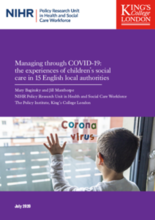As a result of the COVID-19 pandemic, public services are having to rethink how they continue to operate and provide for those most in need of care and support. Amongst the most vulnerable groups, for reasons other than the virus, are children and young people known to children’s service departments. The role and statutory functions of children’s social care (CSC) set out in primary legislation have remained the same during the COVID-19 period1 but it has been necessary to find ways to fulfil these within very changed circumstances.
In the early weeks of March 2020, it was not clear what responses to COVID-19 would be required at a national level and, in planning contingency arrangements, most repondents in this study admitted to balancing many unknowns. The speed with which the local COVID-19 procedures had to be introduced meant that there was little or no time to pilot the arrangements. Local authorities had to work on the assumption that a substantial portion of their workforce could be absent for reasons of illness or would be shielding because of their own or a family member’s condition. But they also wanted to minimise the number of professionals who were travelling around the authorities and beyond as well as the number coming into office buildings.
With a significant proportion of the workforce based at home and the risk of infection leading to prioritisation of families receiving home visits, practitioners used video and telephone calls to fill the gap in communications and contact, not only for visits but also for meetings. Critical service operational procedures, covering everything from risk assessments to virtual working, were produced at short notice by practice leaders and principal social workers.
With lockdown there was immediately an increased level of demand on authorities’ IT systems. Systems usually withstood the massive increase in staff access from home; in some cases it took a while for systems to be upgraded to accommodate up to an eightfold increase in demand. At the same time, information was produced to support best use of the different platforms and how to use them safely. The favoured video platform in local authorities appeared to be Microsoft Teams which is part of Microsoft 365. Where it was not already in place IT teams worked to install it very quickly, particularly as there were problems around other platforms, particularly Zoom and Skype, which led most authorities to discourage their use. Towards the beginning of lockdown there were reports of security breaches on Zoom which meant it was not widely supported across authorities, even though the security issues were addressed very quickly. Skype withstood the security test, but it was only possible to have a limited number of people together at any one time. Often requests to use particular apps that had been turned down previously were agreed. In many authorities, social workers had previously wanted to use WhatsApp to communicate with families but permission to do so had either been withdrawn or the app was not allowed for security reasons. With COVID-19 it was usually allowed.
The urgency of the technological adjustment was characteristic of the speed of response required of local authorities in general and CSC specifically. This research set out to capture the ways in which adaptations were made. It was too soon to be able to judge which might change practice in the longer term, but the findings provide the opportunity to be able to return to this in the future.
This report is based on the experiences of 15 local authority CSC departments that volunteered to participate in the research and whose views were captured between late May and early June 2020. It does not claim to represent a national picture, nor does it reflect the views of parents or of children and young people or, indeed, of other professionals. It is important that these views are also reflected and research that will do so is in progress (see, for example, Ferguson et al., 2020), and no doubt other studies will be commissioned. However, Family Rights Group (FRG) was asked to comment on the impact of the changes identified on families, as reported to them through their helpline. The response is summarised in Annexe 1. Similarly, four independent fostering agencies also read this report in an earlier draft and provided their reflections on fostering in general during this period as well as on their relationships with local authorities (Annexe 2).

